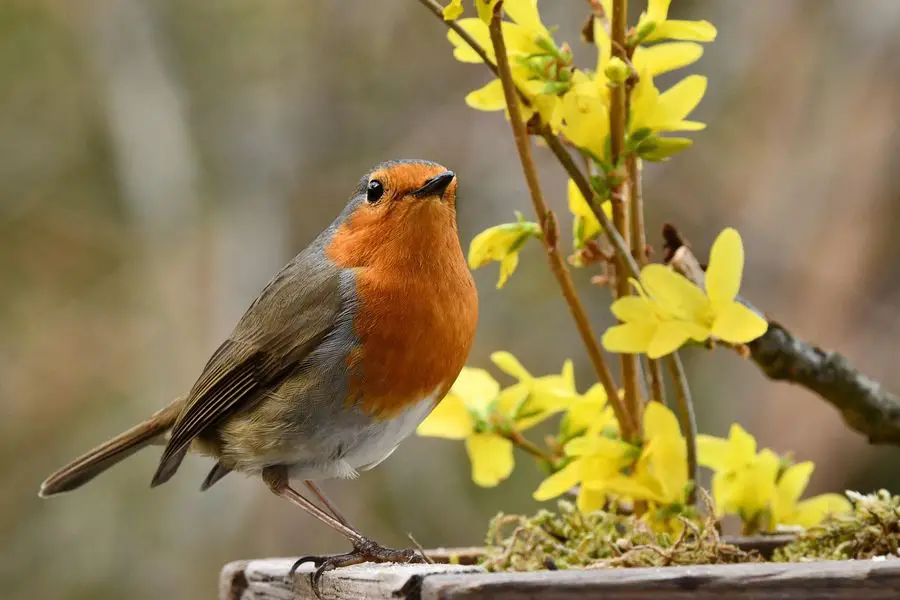During your springtime stroll through parks and gardens, you may have heard the cheerful chirping of birds; most likely, these birds are robins. You probably also caught glimpses of these red-breasted birds darting through trees or hopping across lawns in search of worms.
Robins are among the first signs that spring has arrived, and with them comes one of nature’s most charming rituals: the nesting season.
Robins are prolific and persistent nesters, and they produce blue eggs. They are also known for being dedicated to raising multiple broods each year. They are careful choosers of nesting spots and tireless feeders of their hungry hatchlings.
Understanding when and how robins lay eggs isn’t just for birdwatchers — it offers insight into seasonal rhythms and helps us better protect wildlife.
Main Takeaways
- Robins begin laying eggs in early spring, typically between March and July, depending on climate and location.
- They can have 2 to 3 broods per season, meaning multiple clutches of eggs throughout the spring and summer.
- The full reproductive cycle—from courtship to egg-laying—can occur in just 1–2 weeks, allowing for a quick turnaround between broods.
- American robin eggs are bright blue, smooth, and oval-shaped, usually laid one egg per day until the clutch is complete (3–5 eggs per brood).
- Incubation lasts 12 to 14 days, and only the female incubates the eggs while the male supports by feeding and guarding.
- After hatching, both parents care for the nestlings, feeding them and cleaning the nest until the chicks fledge about two weeks later.
- Robins are protected under laws like the Migratory Bird Treaty Act, making it illegal to handle their nests or eggs without proper authorisation.
- If a robin’s nest seems abandoned, avoid immediate interference—observe from a distance and contact wildlife professionals if necessary.
- Respecting robin nesting areas helps preserve their population and supports broader ecological health.

Photo By: Federico Maderno
When Do Robins Lay Eggs?
Robins typically begin laying eggs in early spring, making them one of the first birds to start the breeding season. The exact timing can vary depending on location and climate, but in most regions of North America, robins lay eggs between March and July.
The process often begins when temperatures consistently warm up and food sources—especially earthworms and insects—are more active. In warmer southern areas, robins might start nesting as early as late February, while in colder northern regions or higher elevations, nesting might not begin until April.
In urban areas with artificial lighting and warmer microclimates, robins may nest slightly ahead of those in rural settings.
Since robins can have two or even three broods in one season, it’s not unusual to see robin eggs in nests well into the summer months. So, if you spot a flash of orange and a scrap of grass dangling from a bird’s beak this spring, chances are, a new clutch of robin eggs is on the way!
Robin Reproduction Cycle
The reproductive journey of a robin is a fast-paced and well-coordinated process. From flirtatious chirps to carefully woven nests, robins don’t waste any time getting down to the business of raising the next generation.
Timeline From Mating to Egg-Laying
Here’s how it typically unfolds:
- Day 0–2: Courtship begins.
- Day 3–6: Nest-building is underway.
- Day 7–8: Mating occurs.
- Day 9 onward: The female begins laying eggs—one per day until the clutch is complete (usually 3–5 eggs).
So, from the start of courtship to the first egg hitting the nest, the entire robin reproduction cycle can take just one to two weeks—a quick turnaround that helps robins raise multiple families in a single season.
Courtship and Nest-Building Behavior
Robin’s romance is surprisingly tender. Courtship includes singing, fluttering, and behaviour known as “courtship feeding,” where the male offers food to the female—kind of like bird date night.
Once a pair bonds, they begin searching for the perfect nesting site, which could be on a tree limb, a windowsill, or even in an old flowerpot.
Nest-building is primarily the female’s job. Using grass, twigs, mud, and sometimes even bits of string or paper, she builds a deep, cup-shaped nest over the course of 2 to 6 days.
How Long Is a Robin “Pregnant” Before Laying Eggs?
Technically, birds like robins don’t experience pregnancy in the same sense as mammalian females.
After mating, eggs in the female robins are fertilised. Once fertilisation occurs, it takes about 24 hours for each egg to fully form and be laid. A female usually lays one egg per day, typically in the early morning.
What Do Robin Eggs Look Like?
Robin eggs are renowned for their beauty and have become a symbol of new springtime.
Colour, Appearance, Size and Shape
The eggs of the American Robin (Turdus migratorius) are distinctive for their vibrant sky blue colour and have been used to identify the “robin’s egg blue.” This hue is so iconic that it has inspired paint colours and fashion trends. The eggs are smooth and glossy, with a uniform colouration and typically lack any speckling or markings.
Robin eggs are oval-shaped and measure approximately 2.8 cm (1.1 inches) in length and 2.1 cm (0.8 inches) in width. Their size and shape are consistent, making them easily identifiable.

Photo By: Jill Wellington
Comparisons with Similar Bird Eggs
While robin eggs are distinctive, several other bird species lay eggs that might appear similar at first glance:
- Bluebird Eggs: Bluebirds, such as the Eastern Bluebird (Sialia sialis), lay eggs that are also blue but typically paler than robin eggs. They are slightly smaller, measuring about 2.1 cm (0.8 inches) in length. The eggs are smooth and may occasionally be white.
- Blue Jay Eggs: Blue Jays (Cyanocitta cristata) lay eggs that are bluish or light brown with darker brown spots. These eggs are larger than robin eggs, measuring approximately 3 cm (1.2 inches) in length, and have a speckled appearance, distinguishing them from the uniform blue of robin eggs.
- Gray Catbird Eggs: Gray Catbirds (Dumetella carolinensis) produce eggs that are light blue, similar in colour to robin eggs. However, they are generally smaller, about 2.3 cm (0.9 inches) in length, and may vary slightly in shade.
How Many Eggs Do Robins Lay?
Robins are prolific breeders, with their egg-laying number varying slightly between species and regions.
American Robin (Turdus migratorius)
- Clutch Size: Typically lays 3 to 5 eggs per clutch.
- Breeding Season: Spans from April to July, during which they may have two to three broods.
- Total Eggs per Season: Given multiple broods, an American robin can lay up to 15 eggs in a single breeding season.
European Robin (Erithacus rubecula)
- Clutch Size: Generally lays 5 to 6 eggs per clutch.
- Breeding Season: Begins in March and may include two to three clutches throughout the season.
- Total Eggs per Season: This results in a potential of 15 to 18 eggs over the breeding period.
Both species exhibit a remarkable ability to raise multiple broods within a single season.
Incubation and Hatching
Once a female robin has laid her clutch, she begins the incubation process to ensure the development and hatching of her offspring.
How Long Does It Take for Robin Eggs to Hatch?
The incubation period for robin eggs is approximately 12 to 14 days from the time the last egg is laid. During this period, the female robin maintains the necessary warmth and humidity by sitting on the eggs almost continuously, leaving only briefly to feed. This consistent incubation is crucial for the proper development of the embryos.

Photo By: Joel Tretheway
Do Male Robins Sit on Eggs?
In the case of American robins (Turdus migratorius), the female exclusively incubates the eggs. Male robins do not possess a brood patch—a specialised area of featherless skin that facilitates heat transfer to the eggs—and, therefore, do not sit on the nest. Instead, the male supports the female by providing food and guarding the nest against potential threats.
Can Robins Move Their Eggs?
Robins are meticulous nest builders, selecting secure and concealed locations to lay their eggs. Once the eggs are laid, robins do not move them. Unlike some bird species, such as ducks or plovers that may roll their eggs to safer spots, robins rely on the initial safety of their chosen nesting site.
Behaviour Around Disturbed Nests H3
If a robin’s nest is disturbed, the adult birds may temporarily abandon it, especially if they perceive a threat. However, they often return once they feel the area is safe again. Robins, as said before, are unlikely to relocate their eggs to a new nest. Therefore, minimising disturbances near a robin’s nest is crucial to ensure the safety and development of the eggs.
What Happens After Hatching?
Once robin chicks hatch, they are altricial—born blind, featherless, and entirely dependent on their parents for warmth, protection, and nourishment.
Nestling Care
For the first 13 to 14 days, the nestlings remain in the nest, during which both parents are actively involved in feeding them. The chicks are fed a diet rich in protein, primarily consisting of insects and earthworms. As the nestlings grow, their diet gradually includes a mix of invertebrates, seeds, and fruit. The parents also maintain nest hygiene by removing faecal sacs to keep the nest clean and reduce the risk of disease.
Parental Roles After Hatching
In American robins (Turdus migratorius), both parents share responsibilities after the chicks hatch. The female continues to brood the young to keep them warm, especially during the early days. Both parents feed the nestlings, but the female often does more of the feeding. Once the nestlings fledge—typically between 14 to 16 days after hatching—the male may take on the primary role of caring for the fledglings, feeding them and teaching them survival skills, while the female begins constructing a new nest for the next brood.
In European robins (Erithacus rubecula), a similar division of labour is observed. Both parents feed the chicks, and after fledging, the young remain in their parents’ territory until they become independent.
This coordinated parental effort ensures that the fledglings receive adequate care and guidance during their critical early stages of life.
Robins: Legal Considerations
In many regions, robins are protected under laws such as the Migratory Bird Treaty Act. This legislation makes it illegal to move or destroy active nests containing eggs or chicks without proper authorisation. If a nest poses a safety concern or is in an inconvenient location, it’s advisable to consult with local wildlife authorities before taking any action.
Best Practices Around Robin Nests:
- Avoid Disturbance: Limit activity near the nest to prevent causing stress to the adult robins.
- Do Not Touch: Refrain from handling the nest or eggs, as this can lead to abandonment.
- Seek Professional Advice: If intervention is necessary, contact local wildlife rehabilitators or authorities for guidance.
Can You Eat Robin Eggs?
While robin eggs are indeed rich in nutrients, including high-quality protein and healthy fats, consuming them is both illegal and unethical.
Legal Protections Under the Migratory Bird Treaty Act
In the United States, robins are protected under the Migratory Bird Treaty Act (MBTA) of 1918. This federal law makes it unlawful to “take”—which includes killing, capturing, selling, or possessing—any migratory bird, their eggs, or nests without proper authorisation from the U.S. Fish and Wildlife Service. Violations can result in significant penalties, including fines and imprisonment.
The MBTA was enacted to address the decline of bird populations due to commercial exploitation and habitat destruction. By protecting species like the robin, the act aims to preserve biodiversity and maintain ecological balance.
Ethical Considerations
Beyond legal implications, there are ethical reasons to avoid consuming robin eggs. Robins play a vital role in ecosystems by controlling insect populations and dispersing seeds. Disturbing their nests or consuming their eggs can disrupt these ecological functions and negatively impact local biodiversity.
How to Care for Robin Eggs (If Necessary)
Discovering a robin egg or nest that appears abandoned can be concerning. However, it’s crucial to approach the situation with care, as robins are protected under wildlife conservation laws, and improper handling can be both harmful to the birds and legally unauthorised.
Observe Before Intervening
Often, what seems like an abandoned nest is not. Robins may leave the nest temporarily to feed or avoid drawing attention to it. Additionally, they typically begin incubating only after laying the full clutch of eggs. It’s advisable to monitor the nest from a distance for at least a few hours to determine if the parents return. Avoid frequent checks, as excessive disturbance can deter the parents from returning.
Legal and Ethical Considerations
In many countries, including the United States, robins are protected under laws. This legislation makes it illegal to handle, move, or possess robin eggs without proper authorisation. Violations can result in significant fines and penalties.
If Intervention Seems Necessary
If, after careful observation, you believe the nest has been abandoned (e.g., no adult activity for over 24 hours, eggs are cold to the touch), consider the following steps:
- Contact a Wildlife Professional: Reach out to a licensed wildlife rehabilitator or local wildlife agency for guidance. They have the expertise and legal authority to handle such situations appropriately.
- Avoid DIY Incubation: Attempting to incubate robin eggs at home is highly discouraged. Successful incubation requires precise temperature and humidity control, regular turning of the eggs, and post-hatching care that mimics natural conditions. Without proper equipment and experience, the chances of survival are minimal.
Preventive Measures
To minimise the likelihood of encountering abandoned nests:
- Limit Disturbance: Avoid frequent activity near known nesting sites during the breeding season.
- Educate Others: Inform family members, especially children, about the importance of not touching or disturbing bird nests and eggs.
By respecting these guidelines, you contribute to the conservation of robins and other native bird species.
Conclusion
Robins are more than just a cheerful sign of spring—they are fascinating, hardworking birds whose nesting habits reveal a great deal about the cycles of nature.
From the moment courtship begins to the hatching of their signature blue eggs, robins follow a well-timed and efficient reproductive process. These birds typically lay their eggs between March and July, depending on climate and location, and may raise multiple broods in a single season.
Understanding when robins lay eggs and how they care for their young helps deepen our appreciation for these common backyard birds and reinforces the importance of protecting their nesting habitats.
With strict legal protections in place and ethical considerations in mind, it’s crucial for us to observe and admire robins from a respectful distance. By doing so, we support their role in maintaining healthy ecosystems and ensure that their presence continues to make our springtime beautiful.



